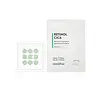What's inside
What's inside
 Key Ingredients
Key Ingredients

 Benefits
Benefits

 Concerns
Concerns

 Ingredients Side-by-side
Ingredients Side-by-side

Trehalose
HumectantSodium Hyaluronate
HumectantCellulose Gum
Emulsion StabilisingGlycerin
HumectantPolyglyceryl-10 Laurate
Skin ConditioningGlycine Soja Oil
EmollientAllantoin
Skin ConditioningDipotassium Glycyrrhizate
HumectantAdenosine
Skin ConditioningRetinol
Skin ConditioningMadecassoside
AntioxidantHyaluronic Acid
HumectantSalicylic Acid
MaskingWater
Skin ConditioningAsiaticoside
AntioxidantMadecassic Acid
Skin ConditioningAsiatic Acid
Skin ConditioningBHT
AntioxidantPropanediol
Solvent1,2-Hexanediol
Skin ConditioningCentella Asiatica Flower/Leaf/Stem Extract
Skin ConditioningEthylhexylglycerin
Skin ConditioningDisodium EDTA
Trehalose, Sodium Hyaluronate, Cellulose Gum, Glycerin, Polyglyceryl-10 Laurate, Glycine Soja Oil, Allantoin, Dipotassium Glycyrrhizate, Adenosine, Retinol, Madecassoside, Hyaluronic Acid, Salicylic Acid, Water, Asiaticoside, Madecassic Acid, Asiatic Acid, BHT, Propanediol, 1,2-Hexanediol, Centella Asiatica Flower/Leaf/Stem Extract, Ethylhexylglycerin, Disodium EDTA
 Reviews
Reviews

Ingredients Explained
These ingredients are found in both products.
Ingredients higher up in an ingredient list are typically present in a larger amount.
1,2-Hexanediol is a synthetic liquid and another multi-functional powerhouse.
It is a:
- Humectant, drawing moisture into the skin
- Emollient, helping to soften skin
- Solvent, dispersing and stabilizing formulas
- Preservative booster, enhancing the antimicrobial activity of other preservatives
Madecassoside comes from the super popular skin-soothing ingredient, Centella asiatica. It is one of four active compounds found in the extract of Centella Asiatica.
Madecassoside has antioxidant, anti-inflammatory, and hydrating properties. It contains fatty acids, amino acids, beta-carotene, and phytochemicals.
One study found using Madecassoside with ascorbic acid helped reduce the signs of aging and improved skin hydration.
Learn more about MadecassosideSalicylic Acid (also known as beta hydroxy acid or BHA) is a well-known ingredient for treating skin that struggles with acne and clogged pores. It exfoliates both the skin's surface and deep within the pores to help clear out buildup, control oil, and reduce inflammation.
Unlike AHAs (alpha hydroxy acids), salicylic acid is oil-soluble. This allows it to penetrate into pores which makes it especially effective for treating blackheads and preventing future breakouts.
Salicylic acid is also known for its soothing properties. It has a similar structure to aspirin and can calm inflamed or irritated skin, making it a good option for acne-prone skin that is also sensitive.
Concentrations of 0.5-2% are recognized by the U.S. FDA as an over-the-counter topical acne product.
It can cause irritation and/or dryness if one's skin already has a compromised moisture barrier, so it's best to focus on repairing that before introducing this ingredient into your routine.
While salicylic acid does not increase sun sensitivity, it’s still important to wear sunscreen daily to protect your skin.
If you are looking for the ingredient called BHA or Butylated Hydroxyanisole, click here.
Learn more about Salicylic AcidSodium Hyaluronate is hyaluronic acid's salt form. It is commonly derived from the sodium salt of hyaluronic acid.
Like hyaluronic acid, it is great at holding water and acts as a humectant. This makes it a great skin hydrating ingredient.
Sodium Hyaluronate is naturally occurring in our bodies and is mostly found in eye fluid and joints.
These are some other common types of Hyaluronic Acid:
Learn more about Sodium Hyaluronate